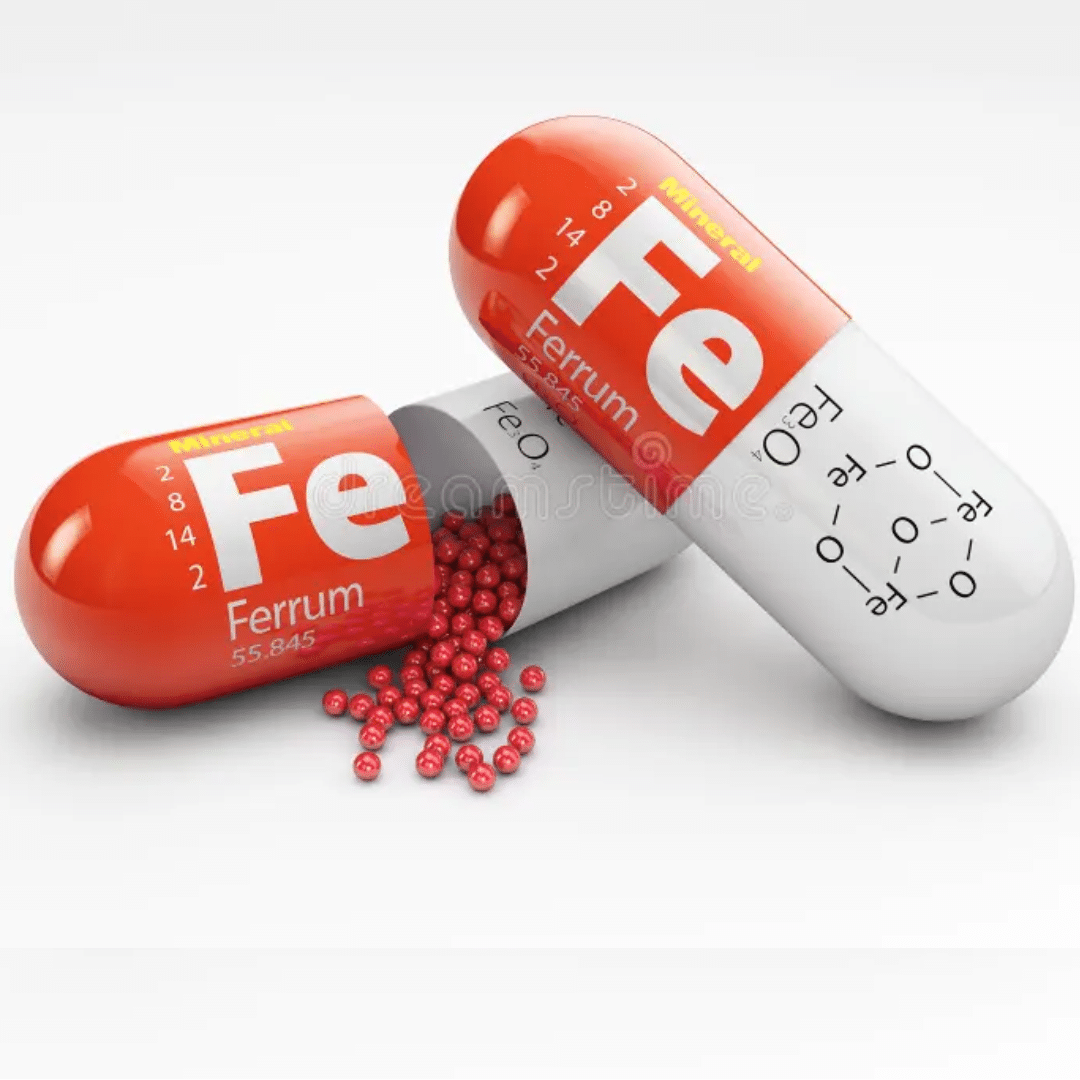Key Concepts
‣ Iron deficiency is the most common nutritional deficiency worldwide. Its prevalence is 12–16% in women and just 2% in men. Clinical experience suggests a correlation between iron levels and hair loss, particularly involving ferritin levels. However, current studies are unable to firmly establish this link due to methodological limitations.
‣ Iron or ferritin levels are not, per se, a direct cause or prerequisite for hair loss. Furthermore, there is no universally accepted minimum ferritin threshold for healthy women, as it is believed that this may vary depending on individual susceptibility to hair loss.
‣ Low ferritin levels are considered a potential risk factor for female hair loss. A significant number of women with Chronic Telogen Effluvium (CTE) may respond positively to iron supplementation (with a target ferritin level >70 ng/mL). This target is recommended in conjunction with any hair restoration treatment.
Iron is an essential trace element and the primary inorganic component of hemoglobin. Its biological functions include participation in energy metabolism (e.g. mitochondrial electron transport), cellular division, protein metabolism, and the synthesis of thyroid hormones.
Many of iron’s critical biological roles are due to its high redox potential, which allows rapid electron transfer between Fe²⁺ and Fe³⁺ states.
Iron is primarily stored in the liver, bound to the storage proteins ferritin and hemosiderin. Iron stimulates the liver to produce ferritin, and serum ferritin levels are a reliable indicator of the body’s iron stores. The total iron content in the human body is approximately 3.8g in men and 2.3g in women.
About 70% of functional iron is found in hemoglobin and serum proteins, 10% in myoglobin (which transports oxygen in muscles), and the remaining 15% is stored for future use in the liver, spleen, bone marrow, and within intracellular proteins
Iron Distribution
Total body iron is classically distributed among three main compartments: storage iron, transport iron, and functional iron:
- Storage iron represents the body’s iron reserves, bound to ferritin and hemosiderin. It is assessed via serum ferritin levels.
- Transport iron is primarily bound to transferrin and is evaluated using zinc protoporphyrin concentration in red blood cells, serum transferrin/total iron-binding capacity (TIBC), serum iron, and transferrin saturation.
- Functional iron includes iron bound to hemoglobin, myoglobin, cytochromes, and non-heme enzymes such as ribonucleotide reductase. It is indirectly measured via hemoglobin concentration and hematocrit levels.
Iron Deficiency
Iron deficiency is the most common nutritional deficiency worldwide, with a prevalence of 12–16% among adolescent girls and women of reproductive age (16–49 years), and 6–9% in women over 50 in the United States. Rates are significantly higher in developing and third-world countries.
In healthy premenopausal women, the most common causes of iron deficiency include menstrual blood loss, pregnancy, and lactation. In postmenopausal women, it is often related to reduced iron absorption or gastrointestinal blood loss.
Key risk factors for iron deficiency include:
- Heavy menstrual bleeding (>80 mL)
- Use of intrauterine devices (IUDs)
- History of iron-deficiency anemia
- Inadequate dietary iron intake
In healthy men aged 16–69, iron deficiency is much less common, with a prevalence of just 2%, while iron-deficiency anemia occurs in less than 1%, typically among individuals engaged in intense physical activity.
Clinical Features
The classic symptoms of iron deficiency mirror those of anemia and may include fatigue and reduced exercise tolerance. Signs of more severe anemia include:
- Pallor of the skin and mucous membranes
- Tachycardia
- Low blood pressure
The consequences of iron deficiency are partly due to reduced oxygen delivery to tissues, and partly due to deficiency in iron-containing molecules. Clinical manifestations may include:
- Restlessness and irritability
- Reduced cognitive performance, especially in adolescent girls
- Fatigue even in non-anemic women
- Most importantly, impaired immune responses and reduced T-cell proliferation
It is crucial to note that some individuals with iron deficiency or even anemia may remain completely asymptomatic.
Progression of Iron Deficiency
Iron deficiency can be considered as a continuum:
- Iron Depletion:
Iron stores are reduced, but transport and functional iron levels remain normal. This leaves little to no iron reserves in the body.
- Iron Deficiency Erythropoiesis (IDE):
Both iron stores and iron transport are diminished. The production of red blood cells is impaired due to inadequate iron availability for their development and function.
- Iron Deficiency Anemia (IDA):
In this final stage, iron storage, transport, and functional levels are significantly reduced, leading to dysfunction in multiple organ systems.
Iron and Hair Loss – General Overview
Iron deficiency has been linked to various disorders of the hair, nails, and skin in general. It has also been associated with generalized pruritus, a symptom that has been documented to improve following the restoration of adequate iron levels. Other conditions such as koilonychia, glossitis, and angular stomatitis—either in isolation or as part of Plummer-Vinson syndrome—have also been connected to iron deficiency.
The association between iron deficiency and hair loss was first observed by Cunningham in 1932 in rats. Later, in 1963, Hord was the first to describe this connection in women. He studied 140 women aged ≤75 years with hair loss, 96 of whom, according to the author, had no significant dermatologic conditions that could account for their hair loss. Among these 96 women, 18 (18.8%) were found to have iron deficiency without anemia.
These 18 women received oral iron supplementation (37–40 mg elemental iron, 1–2 tablets, three times daily), and were followed for a period ranging from 2 months to 2 years. In all 18 cases, hair shedding ceased, hair regrowth was observed, and serum iron levels normalized.
Since then, the relationship between iron status and hair follicle physiology has remained a topic of ongoing investigation and debate. Iron has been implicated in three main types of alopecia:
- Alopecia Areata
- Androgenetic Alopecia/FPHL,
- Chronic Telogen Effluvium (CTE).
In standard dermatology textbooks, iron deficiency is classically cited as a cause of telogen effluvium, even though the supporting evidence remains conflicting.
Up until the early 1990s, the clinical relevance of low iron stores, typically assessed via serum ferritin concentrations, had not been established in women with CTE or FPHL. One key reason for the ongoing disagreement among experts regarding the role of iron in hair loss is that these three conditions have distinct etiologies and should be evaluated individually, rather than grouped together under a single category linked to iron deficiency. However, it is also true that these types of alopecia can coexist simultaneously in the same individual, further complicating the diagnostic and therapeutic approach.
How Iron Deficiency Affects the Hair Follicle
The exact mechanisms through which depleted iron stores impact the hair follicle remain incompletely understood. However, three potential pathways have been proposed:
- Iron as a Cofactor in DNA Synthesis:
Iron functions as a critical cofactor for the enzyme ribonucleotide reductase, which plays a key role in DNA synthesis. Iron deficiency may impair the activity of this enzyme. Dermal papilla cells, known to be among the fastest-dividing cells in the human body, are likely highly sensitive to even minor reductions in iron availability. This sensitivity may lead to a decrease in hair production and, ultimately, clinically evident hair thinning.
- Tissue Hypoxia and Energetic Demand:
Due to their rapid rate of proliferation, dermal papilla cells tend to exhibit lower ferritin levels and higher concentrations of free (labile) iron compared to other cell types. These cells also have significantly higher metabolic demands. A reduction in iron and hemoglobin levels may impair tissue perfusion, potentially leading to localized micro-hypoxia within the follicular environment.
- Inflammatory Processes Related to Iron Deficiency:
A 2010 publication by Vanderford et al. suggests a possible role of mast cells and c-kit antibodies in the context of iron deficiency. Their experimental study in IL-10-deficient mice supports the hypothesis that an iron-dependent inflammatory process could be involved in disrupting the normal physiology of the hair follicle.
At present, it remains unclear which of these mechanisms—or combination thereof—is primarily responsible for hair loss associated with iron deficiency in both men and women.
Challenges in Establishing a Link Between Iron and Hair Loss
The attempt to correlate iron levels with hair loss in both men and women is highly complex. Iron or ferritin levels are neither a definitive cause of hair loss nor a prerequisite for it. A prime example is that approximately 30% of women in the UK, USA, and Japan report symptoms of chronic telogen effluvium (CTE), regardless of their iron status. Conversely, the majority of women, including those with iron deficiency anemia, do not experience hair loss. These conflicting observations alone complicate any causal association between iron deficiency and hair loss.
To accurately determine the relationship between iron deficiency and any form of hair loss, several key elements must be addressed:
- A unified definition of iron deficiency that can be clearly established through standard blood tests, prior to any iron supplementation.
- A reliable population screening test along with a consensus on the use and interpretation of such a test to confirm iron deficiency.
- Targeted evaluation of iron deficiency, especially in women, based on clearly defined hair loss patterns and accompanied by documentation of all relevant variables that may confound the diagnosis.
- Larger study cohorts and well-matched control groups that consider these confounding variables.
- Well-controlled therapeutic trials that include objective hair growth assessments, such as hair counts in defined scalp areas, trichograms in women with confirmed iron deficiency, and measurements of hair shedding before and after iron repletion.
- Evidence supporting the reversal of hair loss following iron repletion.
- Adequate funding for research.
These are not the only necessary conditions for proving a link—let alone a causal one—between a specific finding (like iron deficiency) and a condition (such as hair loss). It is also essential to account for independent variables that may influence outcomes in both the affected group and the control group.
For instance, in studies involving women with hair loss or iron deficiency, nutritional status should be thoroughly evaluated. The following factors must be taken into consideration, as they can significantly affect iron status:
- Age
- Menstrual history: including frequency, duration, and regularity
- Recent pregnancy or miscarriage
- Dietary patterns and avoidance of specific foods: apart from iron and the essential amino acid L-lysine, diet plays a limited role in healthy individuals with unexplained CTE. However, in cases of selective food avoidance, noticeable effects may be seen on both skin and hair.
- Exogenous iron intake, including “hidden” sources such as oral contraceptives.
- Medical conditions or medications that may lead to blood loss, such as corticosteroids, anticoagulants, or NSAIDs.
- Excessive zinc intake from over-the-counter supplements, high consumption of tannin- and manganese-containing teas, or the simultaneous intake of calcium with meals or with iron supplements, all of which can impair iron absorption.
Each of these variables may distort lab results and contribute to the partially increased risk of iron deficiency seen in those with hair loss. Therefore, it is crucial that study populations are carefully selected to control for these factors. Additionally, hair loss itself may lead to behavioral changes that secondarily contribute to iron deficiency. For example, individuals suffering from depression as a result of hair loss may experience poor dietary habits, further exacerbating iron deficiency. Considering all these parameters, it is not surprising that the association between iron and hair loss remains controversial and has yet to achieve widespread scientific consensus.
Although the studies published up to 2013 are extensive and methodologically sound, the sheer number of confounding variables outlined above ultimately weakens their ability to establish a strong and definitive correlation between iron deficiency and hair loss.
Ferritin and Hair Loss
Ferritin levels appear to have a strong correlation with hair loss, although the conclusions are not entirely definitive. Since serum ferritin measurement is considered the most sensitive method for assessing iron stores in the adult population, the key question remains whether low serum ferritin is a causative factor in hair shedding.
The scientific debate begins with the discussion around what constitutes a normal ferritin level in healthy women. This debate is further complicated by the fact that reference ranges vary between laboratories, each of which interprets the literature differently. A ferritin level of 10–15 ng/mL offers a sensitivity of 59% and specificity of 99% for diagnosing iron deficiency in the general population. These rates are considered satisfactory by many, and thus, this threshold is commonly used in clinical settings. However, in premenopausal women, the same threshold provides a sensitivity of 75% and specificity of 98%, while a threshold of 30 ng/mL offers a sensitivity of 92% and specificity of 98%—making it a more reliable diagnostic cut-off.
The validity of these “normal” ranges for serum ferritin and hemoglobin in women has been repeatedly challenged by Rushton et al. The researchers argue that these reference values are derived from populations with inherently high rates of iron deficiency among women. The currently accepted ferritin and hemoglobin standards stem from a large-scale study (n=12,828) conducted by Waalen et al., but Rushton’s meta-analysis of this data revealed that 38% of the women studied were actually iron-deficient, despite being classified within “normal” ferritin ranges.
As a result, reference populations used to define normal iron levels in women may have been mistakenly considered healthy—thereby normalizing what is in fact suboptimal iron status. Rushton and colleagues suggest that this misclassification has led to confusion around what should be considered a “normal” serum ferritin level, particularly in women who may present no clinical signs of deficiency other than chronic telogen effluvium (CTE).
Back in 1990, Rushton et al. were among the first to suggest a link between ferritin levels, fertility, and CTE in women. In cases of iron deficiency anemia (IDA), ferritin stored in growing hair follicles is believed to be mobilized into circulation to support vital organs such as the bone marrow. This resource redistribution may cause hair follicles to prematurely enter the telogen (shedding) phase. Later, in a well-structured and methodologically robust study published in 2000, Kantor et al. confirmed the association between hair loss and low serum ferritin levels. This group proposed the “threshold theory”: iron levels below a certain threshold may trigger hair loss in predisposed individuals, while having no effect on those without such predisposition.
Specifically:
- Ferritin levels <40 ng/mL were strongly associated with an increased number of hair follicles in the telogen phase.
- Ferritin levels between 40–70 ng/mL still showed ongoing hair loss.
- Only at levels >70 ng/mL did hair follicles resume normal cycling and transition back into the anagen (growth) phase.
The double-blind study by Kantor et al. reinforced findings from Rushton’s earlier open-label research and demonstrated that a significant proportion of women with CTE can experience improvement following iron supplementation.
Moreover, evidence suggests there may be a “minimum effective ferritin level” required to optimize treatment outcomes in CTE. While a universally agreed-upon cut-off has not yet been established, a target ferritin level of >70 ng/mL, combined with a normal erythrocyte sedimentation rate (<10 mm/h), is recommended as a therapeutic goal. Ongoing research is focused on determining the most effective supplementation and dietary strategies to maintain ferritin concentrations above this threshold.
General Clinical Recommendation:
For women experiencing hair loss with low ferritin, iron supplementation in the range of 24–48 mg per day is typically advised during the reproductive years. Lower doses may be sufficient for postmenopausal women, given their reduced iron requirements.
Studies Linking Chronic Telogen Effluvium (CTE), Female Pattern Hair Loss (FPHL), and Iron
Hair loss as a clinical symptom affects over 25% of women in developed countries. Female Pattern Hair Loss (FPHL) and Chronic Telogen Effluvium (CTE) represent the majority of hair loss cases. In both conditions, low iron stores are considered a potential contributory factor, with several studies demonstrating a strong correlation between low ferritin levels and hair loss.
A prospective cohort study by Sinclair involving 194 women aged 11 to 72 years, all presenting with CTE lasting six months or more, found that 12 women (6%) had ferritin levels below 20 ng/mL despite normal hemoglobin concentrations. Histologically confirmed FPHL was present in 7 of these 12 women. Patients with FPHL were treated with 200 mg/day of Spironolactone alongside iron supplementation for 3 to 6 months, until ferritin levels rose above 20 ng/mL. Four out of the seven women with FPHL showed a reduction in hair loss and an increase in hair volume, while three showed no improvement. The response rate among patients with FPHL and ferritin levels below 20 ng/mL was similar to that of 108 women with FPHL and normal iron stores who received Spironolactone treatment alone.
Another study by Aydingöz et al. compared 10 women (mean age 32 years) with FPHL, 33 patients with CTE, and 46 healthy controls. This study found no difference in the prevalence of insufficient iron stores or iron deficiency anemia (IDA) among individuals with hair loss compared to controls. Sinclair reported that only 12 out of 194 women with FPHL (6.2%) had ferritin levels below 20 ng/mL, while Aydingöz et al. did not find a significant difference in the frequency of depleted iron stores among patients with diffuse alopecia or FPHL compared to controls (32.5% versus 45.6%).
In a prospective, controlled study, Rushton et al. examined 40 premenopausal women aged 18-47 with FPHL. Twenty women received treatment with cyproterone acetate (CPA) for 12 months, while the other 20 formed the control group. Within each group, 10 women had ferritin levels above 40 ng/mL, and all had hemoglobin concentrations greater than 11.0 g/dL. A significant increase in mean total hair density and notable differences in hair density were observed in treated patients with ferritin levels above 40 ng/mL. Patients with ferritin below 40 ng/mL showed no significant change in mean hair density. The control group exhibited a significant decrease in mean total hair density (p<0.05) and visible hair density (p<0.05). Additionally, no relationship between ferritin levels and hair loss was found in the control group. Rushton et al. also studied 100 premenopausal women aged 14-54 presenting with CTE and 20 controls aged 17-49. From these, 50 patients (72%) had ferritin levels below 40 ng/mL, which was also the minimum control value.
Deloche et al. from L’Oréal Recherche, leveraging the SU.VI.MAX epidemiological study, evaluated a cohort of 5,110 women to investigate a potential relationship between FPHL and iron stores, assessed by ferritin levels. This was the first study conducted in such a large female cohort and provided strong evidence supporting a link between inadequate iron stores and hair loss, particularly in premenopausal women. Specifically, among women with extensive hair loss, 59% had iron levels below 40 mg/L compared to 48% in the general population, with insufficient iron stores considered a risk factor for hair loss.
These conclusions align with studies by Rushton et al., who propose that reductions in serum ferritin levels may represent a risk factor for CTE. For example, a 30-unit decrease in serum ferritin levels in premenopausal women with an initial ferritin concentration of 70 ng/mL results in a 28% increased likelihood of developing CTE. This finding is further supported by a 2009 publication by Moeinvaziri et al. in 30 women with CTE, reporting that women with ferritin levels below 30 ng/mL had a more than 2000% higher likelihood (OR=21.0) of developing CTE.
In cοntrast to these findings, a recent 2010 study by Olsen et al., published in the Journal of the American Academy of Dermatology (JAAD), examined whether iron deficiency was more common in 381 women with FPHL and/or CTE compared to 76 women without hair loss. The conclusion was that the frequency of iron deficiency in pre- or postmenopausal women with androgenetic alopecia or CTE was not higher than that of the control group. As Olsen notably stated in the title of her earlier 2005 publication, “Iron deficiency and hair loss: the jury is still out”, a definitive conclusion regarding the correlation between iron, ferritin, and hair loss has yet to be reached.
Topical Iron Solution
Regarding the topical application of iron on the scalp, the available reports are intriguing, though limited in number. In the initial study by Hirobe, ferrous ferric chloride (FFC) was shown to stimulate the proliferation of keratinocytes, melanoblasts, and melanocytes in animal models. Subsequent studies by the same researcher demonstrated that FFC also promotes the proliferation of keratinocytes, melanocytes, and fibroblasts in cultured human cells. In Hirobe’s most recent study, FFC was reported to stimulate cellular metabolic processes and promote hair growth in mice. However, firm conclusions cannot be drawn from this publication because the two FFC solutions tested—FFC Super Essence Plain Type® and FFC Super Essence Moisture Type®—contained multiple botanical ingredients potentially affecting hair follicle physiology, such as rose oil, grape seed oil, and jojoba oil.
Furthermore, topical iron has been reported to enhance hair follicle growth when combined with 5-aminolevulinic acid (5-ALA), a compound widely used in photodynamic therapy. Ishino et al. demonstrated that 5-ALA can inhibit hair loss; however, its phototoxic effect may paradoxically cause hair breakage if the patient is exposed to sunlight. To address this issue, combinations of 5-ALA with iron salts and urea were developed and applied in patients with androgenetic alopecia. In a study by Tanaka et al., a mixture of 5-ALA, urea, and iron was applied to 20 men with androgenetic alopecia over four weeks. The authors reported increased hair growth and even proceeded to patent the formulation. A subsequent publication by Morokuma et al., testing the same mixture on mice, found hair growth stimulation comparable to a 5% Minoxidil solution.
Nonetheless, the photosensitivity induced by 5-ALA limits its appeal as a treatment for androgenetic alopecia. As of late 2012, no such topical iron-based products are commercially available.
Dietary Sources of Iron
Iron is found in both animal- and plant-based foods. Dark leafy vegetables, such as parsley and spinach, as well as dried figs, contain significant amounts of iron. Foods rich in iron include all red and white meats, while fortified breakfast cereals often provide iron levels sufficient to meet daily requirements. However, iron absorption from meat and dairy products ranges between 20-30%, whereas absorption from plant-based sources is only about 25%. Iron absorption capacity decreases with age, making it beneficial to consume iron together with vitamin C or vitamin A, which can enhance absorption by up to 50%, especially when the iron is derived from plant sources.
Iron Requirements
The Recommended Daily Allowance (RDA) for adult men is 8 mg, and a diet containing sufficient fruits for vitamin C intake ensures proper absorption of this amount of iron. The RDA for adolescent girls is 15 mg, for premenopausal women it is 18 mg, and for pregnant or breastfeeding women, it rises to 27 mg. A normal diet provides the necessary iron, as the human body is capable of recycling iron and replenishing what is naturally lost through dietary intake. The human body absorbs approximately 15% of the iron consumed from food but can increase absorption in cases of deficiency or decrease it in cases of excess. The Adequate Intake (AI) level is set at 6 mg, while the Tolerable Upper Intake Level (UL) is 45 mg for all ages and both sexes.
Deficiency – Excess – Safety
In men, the most common causes of iron deficiency include regular use of anti-inflammatory medications, which can cause micro-bleeding in the stomach leading to iron loss, as well as iron malabsorption due to gastric disorders. Frequent blood donation has also been implicated as a cause of iron deficiency.
In women, iron deficiency is primarily caused by monthly blood loss during menstruation, especially in women who do not consume adequate amounts of iron from red meat, those experiencing menorrhagia (excessive menstrual bleeding >80 ml per cycle), those following vegetarian diets, and women with already diminished iron stores. Prolonged iron deficiency leads to iron deficiency anemia (IDA), characterized by symptoms such as fatigue, weakness, shortness of breath, dizziness, difficulty concentrating, mouth ulcers, and hair loss.
Once IDA develops, ferritin production by the liver ceases. Biochemical blood tests measuring iron, ferritin, transferrin levels, as well as a complete blood count to confirm IDA, are essential before initiating iron supplementation, which is only indicated in confirmed deficiency or IDA cases. In these situations, ferrous iron formulations are preferred over ferric forms due to better absorption. Because iron supplementation is often associated with gastrointestinal side effects, the dosage should be gradually increased and taken with meals, divided into multiple doses rather than a single dose. The maximum tolerated daily iron dose for healthy men is 45 mg and 75 mg for women, but this always depends on serum iron levels and body stores.
Iron doses exceeding 100 mg have the potential to accumulate in the liver and other organs, leading to toxic effects. Therefore, dosages should never be exceeded.
Current Conclusions
Assessment of ferritin levels has become a routine part of clinical evaluation, and dermatologists frequently prescribe iron supplements to women experiencing hair loss, operating under the assumption that low iron stores contribute to hair thinning. However, epidemiological data remain conflicting and have yet to provide strong evidence to support this practice. Various observational studies examining the relationship between low ferritin levels and hair loss have also produced inconsistent results. Iron deficiency without anemia had not been systematically studied until recently as a causative factor for hair loss in women, nor had the significance of iron stores—assessed via serum ferritin levels—in women with hair loss been fully elucidated.
Some experts believe the role of iron levels in female hair loss may be overestimated, noting that the majority (61.9%) of women with hair loss due to Female Pattern Hair Loss (FPHL), Chronic Telogen Effluvium (CTE), or a combination of both have ferritin levels above the cutoff point of 30 ng/mL, which corresponds to a sensitivity of 92% and specificity of 98% for diagnosing iron deficiency. Nevertheless, studies by Rushton et al. suggest that a more effective ferritin target level is around 70 ng/mL. Conversely, iron deficiency has not been associated with androgenetic alopecia in men in any study to date. As of 2012, there is insufficient evidence to justify widespread population screening of iron levels in patients with hair loss, and data remain inadequate to recommend iron supplementation in patients with hair loss and low ferritin who do not have iron deficiency anemia (IDA).
Decisions regarding testing or treatment should rely on the clinician’s judgment. It is preferable not to attribute hair loss solely to low iron stores without thorough evaluation and exclusion of alternative causes. Prompt initiation of hair growth-promoting therapy should be prioritized. However, since FPHL is common in women and the capacity to reverse it through oral anti-androgen therapy is limited, a concurrent goal should be to maintain ferritin levels above 70 ng/mL to support the efficacy of any hair regrowth treatment.
Summary
The main challenges in correlating hair loss with iron levels lie firstly in the fact that the causes of hair loss often overlap chronologically in the same patient, and secondly in the lack of consensus regarding the minimum normal ferritin level. The extent to which low serum ferritin constitutes a causal factor for hair loss, the specific types of hair loss involved, and the exact concentration threshold at which mechanisms linked to low ferritin trigger hair loss remain unclear. It is a misconception to oversimplify by assuming that reduced ferritin levels in a woman with hair loss automatically explain the cause of her condition.
Simultaneously, it is prudent that before initiating hair regrowth treatment in these women, efforts are first made to raise ferritin levels above 70 ng/ml, and only on this “foundation” should treatment be administered.
Source: Konstantinos Anastasakis MD, PhD, “Androgenetic Alopecia from A to Z”, Dietary Supplements and Androgenetic Alopecia, pp. 407-414, 2nd Edition, Zevelekakis Publications, Athens 2017











